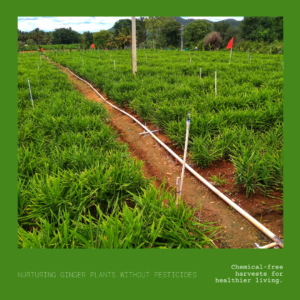
Do you want to harvest more ginger in less time? If so, then this article is for you! Ginger is a popular spice and medicinal herb that can be grown in your own backyard. However, growing ginger requires the right techniques and conditions to ensure fast growth and a bountiful harvest. Luckily, our experts have compiled a list of fast-growth tactics that are guaranteed to boost your ginger growth and harvest.
Key Takeaways
- Expert-approved tactics can help boost ginger growth and enhance your harvest.
- Choosing healthy rhizomes is crucial for successful ginger growth.
- Preparing the planting bed with organic matter and proper drainage can promote optimal growth.
- Providing ideal growing conditions such as optimal temperature, sunlight, and moisture levels is key to success.
- Nurturing ginger plants with proper fertilization and pest control can promote robust growth.
Selecting Healthy Ginger Rhizomes
Choosing the right ginger rhizomes is essential for a successful harvest. Before planting, examine the rhizomes carefully to ensure you’re selecting healthy ones with good quality and condition. Follow these expert tips for selecting the best ginger rhizomes:
Appearance
Look for firm, plump ginger rhizomes with tight skin. Avoid those with wrinkles, soft spots, or cuts since they indicate poor quality and might not sprout. A vibrant yellow color is a sign of good health, while dull or faded skin can indicate inadequate growing conditions or age.
Texture
The ginger rhizome should feel heavy in your hands and have a little give when you squeeze it. If it feels light or spongy, it’s not healthy and might not sprout.
Size and Shape
Choose rhizomes that are at least two inches long and have several “fingers.” The more fingers a rhizome has, the more shoots it will produce and the larger your harvest will be. Avoid rhizomes that are too small or thin, as they might not be mature enough to sprout.
Expert Tip: Purchase ginger rhizomes from a reputable source to ensure their quality and condition.
By following these tips, you’re laying a strong foundation for your ginger growth and ensuring a successful harvest.
Preparing the Planting Bed
Before planting ginger, it is crucial to prepare the planting bed properly. Start by clearing the area of any debris, rocks, or weeds that may affect the growth of the ginger plants. Ensure that the area receives ample sunlight and is well-drained to prevent waterlogging.
Next, add organic matter such as compost or well-aged manure to the soil. This improves soil fertility, structure, and water-holding capacity, making it easier for the ginger to grow.
If the soil in your planting area has poor drainage, consider creating raised beds to improve soil drainage and prevent waterlogging. This is especially important for growing ginger, as waterlogged soil can lead to root rot and stunted growth.
The Benefits of Adding Organic Matter to the Soil
| Benefits of Organic Matter | Types of Organic Matter |
|---|---|
| Increase soil fertility | Compost |
| Improve soil structure | Well-aged manure |
| Enhance water-holding capacity | Leaf mold |
By preparing the planting bed properly, you can create optimal conditions for your ginger plants to thrive. The addition of organic matter and improved soil drainage will provide the necessary nutrients and oxygen to promote healthy growth.
Planting Ginger

Planting ginger properly is essential for the growth and development of healthy ginger plants. Make sure to follow these guidelines to ensure optimal growth and a bountiful harvest.
Preparing Ginger Rhizomes
Before planting ginger, select healthy rhizomes that are firm and free from mold and soft spots. It’s also important to allow them to dry in a shaded area for a day or two before planting.
Spacing and Depth
The proper spacing and depth for ginger rhizomes are critical factors in plant growth. Space the rhizomes 8-10 inches apart in rows that are 12-16 inches apart. Plant the rhizomes 2-4 inches deep, with the buds facing up and the roots facing down.
Note: Remember to make sure your soil is well-draining to prevent waterlogging, which can damage rhizomes.
Mulching
Mulching is a great way to retain moisture and prevent weed growth in ginger plants. After planting, add a 2-3 inch layer of organic mulch, such as straw or shredded leaves.
Watering Techniques
Provide consistent moisture levels to your ginger plants by watering them regularly. Make sure to water deeply, saturating the soil to a depth of 6 inches. However, avoid over-watering, as this can cause rotting of the rhizomes.
Providing Ideal Growing Conditions
Ginger plants thrive in ideal growing conditions that provide optimal temperature, sunlight requirements, and consistent moisture levels. To achieve successful ginger growth, it is important to maintain these conditions throughout the growing season.
Optimal Temperature
The ideal temperature for ginger growth is between 68-77°F (20-25°C). Temperatures that are too high or too low can inhibit growth and reduce the yield. To achieve optimal temperature, consider planting ginger in early spring or late summer when temperatures are mild.
Sunlight Requirements
Ginger plants need plenty of sunlight to grow and thrive. To ensure they receive enough sunlight, plant ginger in a location with partial to full sunlight. Four to six hours of direct sunlight a day is ideal for optimal growth.
Consistent Moisture Levels
Ginger plants require consistent moisture levels to grow well. During the growing season, ensure that the soil is consistently moist, but not waterlogged. Overwatering can cause root rot and hinder growth. Consider using a drip irrigation system to provide consistent moisture levels, especially during dry periods.
Nurturing Ginger Plants

After planting your ginger rhizomes, it’s essential to nurture the plants to promote robust growth. Fertilization and proper nutrient requirements are vital components of ginger plant care. A balanced, organic fertilizer can help provide essential nutrients, including nitrogen, phosphorus, and potassium, necessary for healthy growth. Apply the fertilizer evenly around the base of the plant, ensuring to follow the manufacturer’s instructions on the correct dosage.
To ensure optimal growth, controlling pests and diseases is essential. Some of the common pests and diseases that affect ginger plants include spider mites, aphids, and root knot nematodes. Ensure you inspect your plants regularly and take measures to control the pests and diseases with the appropriate methods. Take care not to use strong chemical pesticides that could damage your plants.
Ginger plants require consistent moisture levels to thrive, so ensure that the soil remains slightly moist, especially during dry spells. Overwatering can cause the roots to rot. Ensure to mulch around the plants to help retain moisture and control weeds. Proper care and attention are crucial to nurturing ginger plants, leading to a bountiful yield.
Harvesting Ginger
Harvesting ginger at the right time is crucial to ensure a bountiful and high-quality crop. The signs of maturity and readiness for ginger plants are when the leaves start to turn yellow and the stem begins to wilt. Another indicator is when the ginger rhizomes become plump and the soil starts to dry out.
When harvesting ginger, always use proper techniques to preserve the quality of your crop. Start by clearing away the soil around the base of the plant, and gently pulling the ginger rhizomes from the soil. Take care not to damage the ginger roots or rhizomes during this process.
Avoid washing the ginger rhizomes immediately after harvesting, as this can shorten their shelf life. Instead, wipe away any excess dirt with a soft cloth or brush. Let them dry completely before storing them in a cool, dry place away from direct sunlight.
Proper harvesting techniques play a crucial role in preserving the quality of ginger crops. Adhering to these practices ensures that you have ginger of the highest quality, perfect for consumption or for use in various recipes.
FAQ
Q. How do I select healthy ginger rhizomes for planting?
A. To select healthy ginger rhizomes, examine their quality and condition. Look for firm, plump rhizomes with smooth skin and visible buds or “eyes.” Avoid any rhizomes that are shriveled, moldy, or damaged.
Q. What should I do to prepare the planting bed for ginger?
A. To prepare the planting bed, start by clearing the area from weeds and debris. Then, add organic matter such as compost or well-rotted manure to improve soil fertility. Additionally, ensure good soil drainage by loosening the soil and creating raised beds if necessary.
Q. What is the proper spacing and depth for planting ginger rhizomes?
A. Plant ginger rhizomes with a spacing of about 8 to 10 inches apart, with each rhizome placed about 1 to 2 inches deep in the soil. Be sure to position the rhizomes with the buds facing upward for proper growth.
Q. How should I mulch and water ginger plants?
A. Mulch around ginger plants with a layer of organic material, such as straw or shredded leaves, to conserve moisture and suppress weed growth. Water ginger plants regularly, keeping the soil consistently moist but not waterlogged. Avoid overwatering, as it can lead to rotting of the rhizomes.
Q. What are the ideal growing conditions for ginger?
A. Ginger thrives in warm and humid environments. Provide it with temperatures between 70 to 90°F (21 to 32°C) and a minimum of 6 hours of sunlight daily. Additionally, maintain a consistently moist soil, avoiding extreme dryness or waterlogging.
Q. How should I fertilize and care for ginger plants?
A. Fertilize ginger plants every four to six weeks using a balanced organic fertilizer. Keep the soil well-nourished with compost or compost tea. Monitor for pests and diseases, and apply appropriate organic treatments if necessary to ensure healthy growth.
Q. How can I tell when ginger is ready to harvest?
A. Ginger is ready to harvest when the leaves turn yellow and start to dry out. Dig carefully and feel for the rhizomes. Harvest only what is needed, leaving a portion in the ground to continue growing. Avoid harvesting ginger too early, as it may result in underdeveloped rhizomes.
Q. What are the proper harvesting techniques for preserving ginger quality?
A. When harvesting ginger, gently dig around the rhizomes to avoid damaging them. Shake off excess soil and cut off the stems close to the rhizomes. Wash the ginger rhizomes carefully to remove any remaining dirt. Allow the ginger to air dry before storing it in a cool, dry place.
Conclusion
Congratulations on taking the first step toward a bountiful ginger harvest! By implementing these expert-approved tactics and fast-growth techniques, you can significantly boost your ginger growth and achieve a bumper crop in no time.
Remember to start by selecting healthy rhizomes and preparing your planting bed with organic matter and proper soil drainage. Provide your ginger plants with optimal growing conditions, including the right temperature, sunlight, and consistent moisture levels. Nurturing your plants with the right fertilization and pest control will also promote healthy growth.
When it’s time to harvest, be sure to look out for the signs of maturity and readiness to ensure a high-quality yield. With these tips in mind, you’ll be on your way to a successful ginger harvest in no time!
















